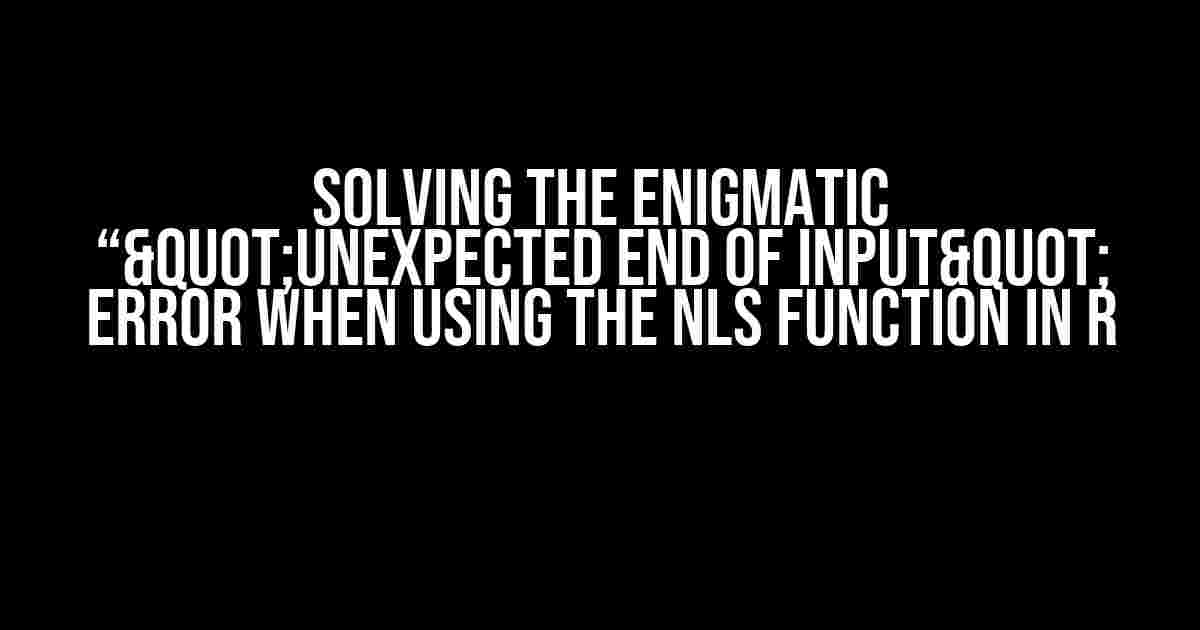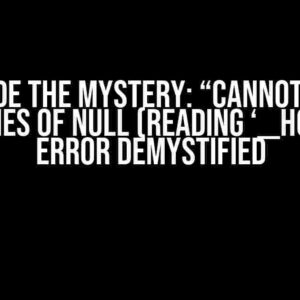If you’re an R enthusiast, you’ve probably stumbled upon the notorious “"unexpected end of input" error when trying to use the nls (non-linear least squares) function. This error can be frustrating, to say the least, especially when you’re in the midst of a critical project. Fear not, dear reader, for we’re about to embark on a journey to demystify this error and provide a comprehensive guide to overcome it.
What is the NLS Function in R?
The nls function in R is a powerful tool for fitting non-linear models to data. It’s an implementation of the non-linear least squares algorithm, which allows you to estimate the parameters of a non-linear function that best fit your data. The function takes three main arguments: the formula, the data, and the starting values for the parameters.
nls(formula, data, start)In the formula argument, you define the non-linear function you want to fit to your data. The data argument specifies the data frame containing the variables to be used in the model. Finally, the start argument provides the initial values for the parameters to be estimated.
The “"unexpected end of input" Error: What’s Causing It?
So, why does the “"unexpected end of input" error occur when using the nls function? The error message can be misleading, as it doesn’t provide much insight into the root cause of the problem. After digging deeper, we can identify a few common culprits:
- Syntax errors in the formula: A single misplaced character or an incorrect syntax can lead to this error. Make sure to double-check your formula for any typos or syntax mistakes.
- Incorrect data types: The nls function expects numerical data, so ensure that your data is in the correct format. If your data includes non-numeric values, such as characters or factors, the function will throw an error.
- Missing or infinite values: The presence of missing or infinite values in your data can cause the nls function to fail. Check your data for any missing or infinite values and remove or replace them accordingly.
- Insufficient starting values: The nls function requires reasonable starting values for the parameters. If the starting values are far off from the actual values, the function may fail to converge, resulting in the “"unexpected end of input" error.
- Model misspecification: Sometimes, the model itself can be the issue. If the non-linear function is misspecified, the nls function may struggle to converge, leading to the error.
Solving the “"unexpected end of input" Error: Step-by-Step Guide
Now that we’ve identified the potential causes, let’s walk through a step-by-step guide to overcome the “"unexpected end of input" error:
Step 1: Check the Formula Syntax
# Define the formula
formula <- y ~ a * x^b
# Check the syntax
parse(text = formula)Use the parse() function to check the syntax of your formula. If there are any errors, the function will throw a warning or an error message, indicating the specific issue.
Step 2: Verify Data Types and Structures
# Check the data types
str(mydata)
# Check for non-numeric values
sum(!is.numeric(mydata))Use the str() function to inspect the data types and structures of your data. Make sure that all variables are numeric. If you find non-numeric values, convert them to numeric or remove them accordingly.
Step 3: Handle Missing or Infinite Values
# Check for missing values
sum(is.na(mydata))
# Check for infinite values
sum(is.infinite(mydata))
# Remove missing or infinite values
mydata <- na.omit(mydata)Use the is.na() and is.infinite() functions to detect missing or infinite values in your data. Remove or replace them using the na.omit() function or other suitable methods.
Step 4: Provide Reasonable Starting Values
# Define the starting values
start_values <- list(a = 1, b = 2)
# Check the starting values
nls(formula, data = mydata, start = start_values)Provide reasonable starting values for the parameters using the list() function. Experiment with different starting values until the nls function converges.
Step 5: Refine the Model (If Necessary)
# Refine the model
formula_refined <- y ~ a * x^b + c * x
# Check the refined model
nls(formula_refined, data = mydata, start = start_values)If the previous steps don't resolve the issue, consider refining the model itself. Add or remove terms to improve the fit and convergence of the model.
Additional Tips and Tricks
In addition to the steps above, here are some extra tips to help you overcome the ""unexpected end of input" error:
- Use the debug() function: The debug() function can help you identify the specific issue in your code. Wrap your nls call with debug() to get more detailed error messages.
- Check for overfitting: Overfitting can cause the nls function to fail. Use techniques like cross-validation or regularization to prevent overfitting.
- Use alternative optimization methods: If the default optimization method fails, try alternative methods like the "port" or "nlminb" algorithms.
- Consult the documentation: The nls function has an extensive documentation. Consult the help files and vignettes for more information on syntax, usage, and troubleshooting.
Conclusion
The ""unexpected end of input" error when using the nls function in R can be frustrating, but it's not insurmountable. By following this comprehensive guide and tips, you'll be well-equipped to overcome this error and unlock the full potential of the nls function. Remember to double-check your syntax, data types, and starting values, and don't hesitate to refine your model or seek additional help when needed.
| Troubleshooting Checklist | √ |
|---|---|
| Syntax errors in the formula | √ |
| Incorrect data types | √ |
| Missing or infinite values | √ |
| Insufficient starting values | √ |
| Model misspecification | √ |
By following this troubleshooting checklist, you'll be able to identify and resolve the ""unexpected end of input" error, ensuring that you can successfully use the nls function in R.
Here are 5 Questions and Answers about "unexpected end of input" error when using the nls function in R:
Frequently Asked Question
Stuck with the frustrating "unexpected end of input" error when using the nls function in R? Don't worry, we've got you covered! Check out these FAQs to troubleshoot the issue.
What causes the "unexpected end of input" error in nls function?
This error often occurs when the nls function encounters an incomplete or malformed formula. This can happen when you forget to close a parenthesis or quote, or when your formula is not well-formed. Double-check your formula to ensure it's correct and complete!
How do I debug the "unexpected end of input" error in nls function?
To debug this error, start by checking the formula argument in your nls function call. Look for any typos, missing parentheses, or unbalanced quotes. You can also try breaking down the formula into smaller parts to isolate the issue. If you're still stuck, try using the `quote` function to enclose your formula, like this: `nls(y ~ x, data = mydata, algorithm = "port", quote$formula)`. This can help identify the problem.
Can I use the `tryCatch` function to handle the "unexpected end of input" error?
Yes, you can use the `tryCatch` function to catch and handle the "unexpected end of input" error. This can be especially useful if you're running multiple nls models in a loop or script. Here's an example: `tryCatch(nls(y ~ x, data = mydata, algorithm = "port"), error = function(e) print("Error: ", e))`. This will catch the error and print a message instead of stopping the script.
What are some common mistakes that lead to the "unexpected end of input" error?
Some common mistakes that can lead to this error include: forgetting to close a parenthesis or quote, using an incomplete or malformed formula, or specifying an incorrect algorithm. Additionally, if your data is not properly prepared or contains missing values, it can also cause issues with the nls function.
How can I prevent the "unexpected end of input" error in the future?
To avoid this error in the future, make sure to always double-check your formula and nls function call. Use a consistent and clear syntax, and try to break down complex formulas into smaller parts. It's also a good idea to test your code on a small dataset before running it on a larger one. Finally, consider using tools like RStudio's code completion and syntax highlighting to help catch errors early on.


